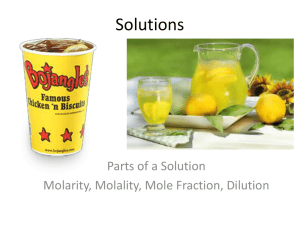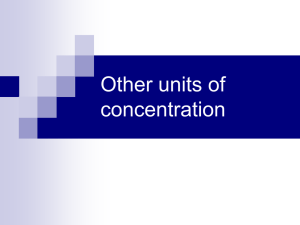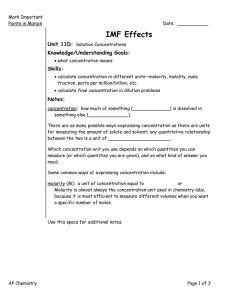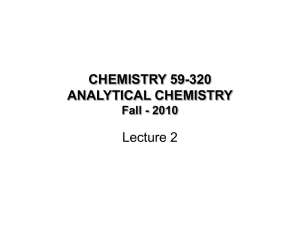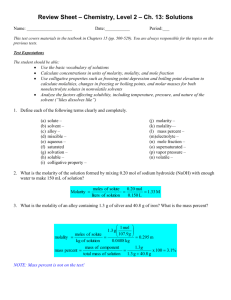A.P. Chemistry
advertisement
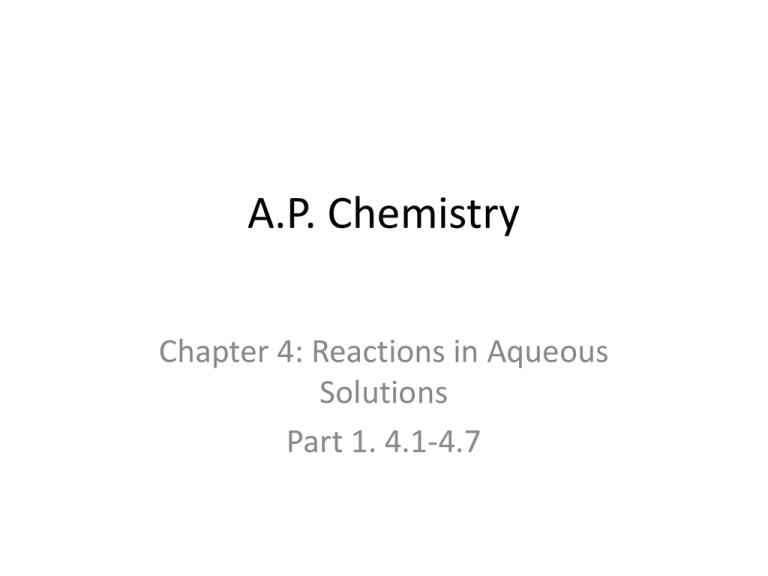
A.P. Chemistry Chapter 4: Reactions in Aqueous Solutions Part 1. 4.1-4.7 4.1 Water, the Common Solvent Definition-solution prepared by dissolving substances in water (aqueous solutions); can be classified as non-electrolyte or electrolyte, depending on their ability to conduct electricity. Water is not a linear molecule; it is bent at an angle of about 105o. Electrons are not evenly distributed around the atoms in the water, making the molecule polar. Draw it. 4.2 The Nature of Aqueous Solutions: Strong & Weak Electrolytes Like dissolves like. (p. 133) The following classes of molecules are miscible: Polar and ionic Polar and polar Nonpolar and nonpolar Ionic salts dissolve in water Example: NaCl(s) Na+1(aq) + Cl-1(aq) CaCl2(s) K2Cr2O7(s) Ba(OH)2(s) Compounds that contain only carbon and hydrogen are nonpolar. Example: Predict whether each pair of substances will mix and indicate why or why not: a. NaNO3 and H2O (y) c. C6H14 (hexane) and H2O (n) b. I2 and C6H14 (y) d. I2 and H2O (n) (What does immiscible mean?) Solution- a homogeneous mixture of two or more substances Solute- the substance present in the smaller amount; or, if it changes phase upon making the solution (p. 134) Solvent- substance present in the larger amount (p. 134) Electrolyte- a substance that, when dissolved in water, results in a solution that can conduct electricity (p. 134) Non-electrolyte- does not conduct electricity when dissolved in water (p. 134) Pure water contains very few ions- poor conductor Water w/ NaCl- because salt dissolves in water, a salt solution is electrolytic Electrolyte Strong Weak Non Conductivity o of Dissociation Examples high total strong acids (HCl); many salts; strong bases (NaOH); other Group 1 and Group 2 hydroxides low-moderate partial weak organic acids; weak bases none close to zero sugar, AgCl, Fe2O3 Example: Which of these would be a strong, weak or non-electrolyte? HClO4 (S) C6H12 (N) LiOH (S) NH3 (W) CaCl2 (S) HC2H3O2 (W) Problem: Identify the following as strong, weak, or nonelectrolyte: a. CH3OH (methyl alcohol) (W) b. CH4 (N) c. Na2CO3 (S) 4.3 The Composition of Solutions Concentration Percent by Mass (p. 514) Percent solute = mass of solute x 100% Mass of solution Percent = mass of solute x 100% Mass of solute + mass of solvent Molarity- number of moles of solute divided by the volume of solution in liters; M (Molarity may change due to change in temperature as volume expands or contracts)(p. 139) Molarity = number of moles of solute Number of liters of solution Example: Calculate the molarity of a solution prepared by dissolving 11.5 g of solid NaOH in enough water to make 1.50 L of solution. 11. 5 g NaOH x 1 mol/40g = 0.2875 mol 0.2875 mol/1.50 L = 0.192 M Problem: Calculate the molarity of a solution prepared by dissolving 1.56 g of gaseous HCl in enough water to make 26.8 mL of solution. 1.56 g HCl x 1 mol/36.5 g = 0.0427 mol 0.0427 mol/0.0268 L = 1.59 M Molality- number of moles of solute per kilogram of solvent; m (molality will not change due to change in temperature; mass is not variable w/ temp. Therefore, use this concentration when working with colligative properties)(p. 514, 551) Molality = number of moles of solute Number of kilograms of solvent Example: A solution is prepared by mixing 1.00 g of ethanol with 100.0 g of water to give a final volume of 101.mL. Calculate the molality, molarity, and mass percent. Molar mass ethanol = 46 g/mol 1.00 g x 1 mol/46 g = 0.0217 mol 0.0217 mol/ 0.101 L = 0.215 M 0.0217 mol/0.100 kg = 0.217 m 1.00 g/101 g x 100% = 0.99 % Problem: The electrolyte in automobile lead storage batteries is a 3.75 M sulfuric acid solution that has a density of 1.230 g/mL. Calculate the mass percent and molality of the sulfuric acid. Mole Fraction (XA, XB)- a dimensionless quantity, no unit XA = number of moles of A # of moles of A + # of moles B Standard Solution (p. 142) –a solution whose concentration is accurately known. Dilution (p. 144-5) –the process of adding solvent to lower the concentration of solute in a solution 4.4 Types of Chemical Reactions (read textbook only; practice in class) 4.5 Precipitation Reactions Precipitate (p. 147) –an insoluble substance that may form when two solutions are mixed together. Basic Solubility Rules: Learn these!! (Table 4.1, p. 150) All Group I metallic salts, ammonium salts, nitrates, acetates, chlorates, and perchlorates are soluble. All chlorides, bromides, and iodides are soluble EXCEPT when with silver, lead (II), or mercury (I) All sulfates are soluble EXCEPT when with lead (II), Ca, Sr, or Ba. Group I, Ca, Sr, Ba metallic oxides are soluble (basic anhydrides) as well as their resulting hydroxides Insoluble (except w/ cations in Rule #1): carbonates, phosphates, sulfides, and bisulfites (hydrogen sulfites). 4.6 Describing Reactions in Solution Full Formula Unit Equation: show complete formulas for all compounds (aka molecular equation) AgNO3(aq) + NaCl(aq) AgCl(s) + NaNO3(aq) Complete Ionic Equation: show the predominant form in which each substance exists when it is in contact with aqueous solution (p. 152) Ag+ + NO3- + Na+ + Cl- AgCl(s) + Na+ + ClNet Ionic Equation: only show the species that react; eliminate spectator ions.(p. 152) Ag+ + Cl- AgCl(s) Spectator Ions (p. 152) Na+ , NO3- 4.7 Stoichiometry of Precipitation Reactions Individual Ion Concentrations when an ionic compound is dissolved in water Example: Give the concentration of each type of ion in the following solutions: 0.50 M Co(NO3)2 (0.50 M Co2+, 1.0 M NO3-1) 1 M Fe(ClO4)3 (1 M Fe3+, 3 M ClO4-) Problem: Calculate the number of moles of chloride ions in 1.75 L of 1.0 x 10-3 M ZnCl2. ZnCl2 Zn2+ + 2Cl1.75 L x 1.0 x 10-3 mol/liter x 2 mol Cl-/1 mol ZnCl2 = 0.0035 mol Chloride ion Example: A 0.5662 g sample of an ionic compound containing chloride and an unknown metal is dissolved in water and treated with an excess of AgNO3 solution. If 1.0882 g of AgCl precipitate forms, what is the percent by mass of Cl in the original compound. % Cl (in AgCl) = 35.45 g/143.25 g x 100% = 24.7% 0.247 x 1.0882 g AgCl = 0.2693 g Cl 0.2693 g/0.5662 g x 100% = 47.6%


